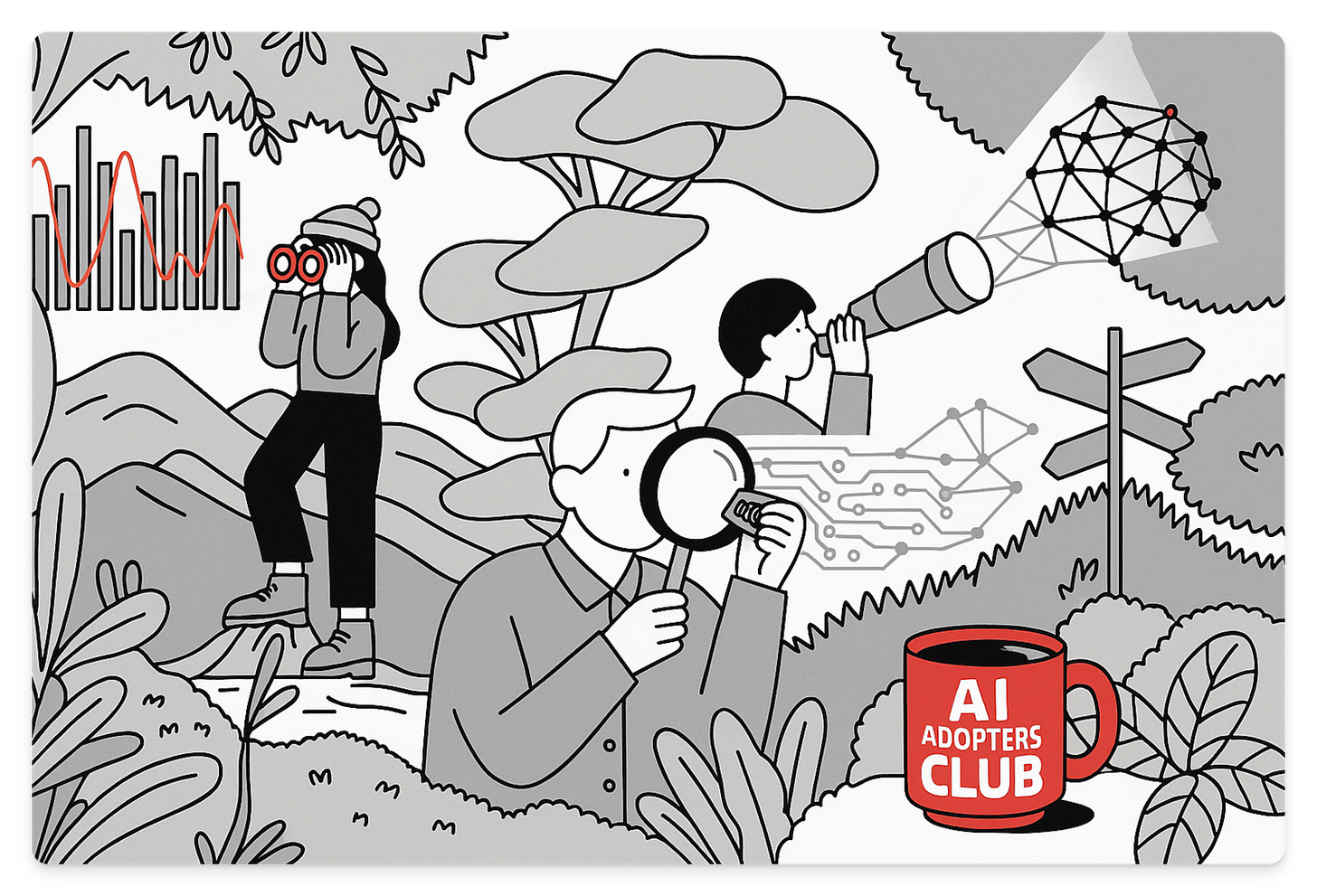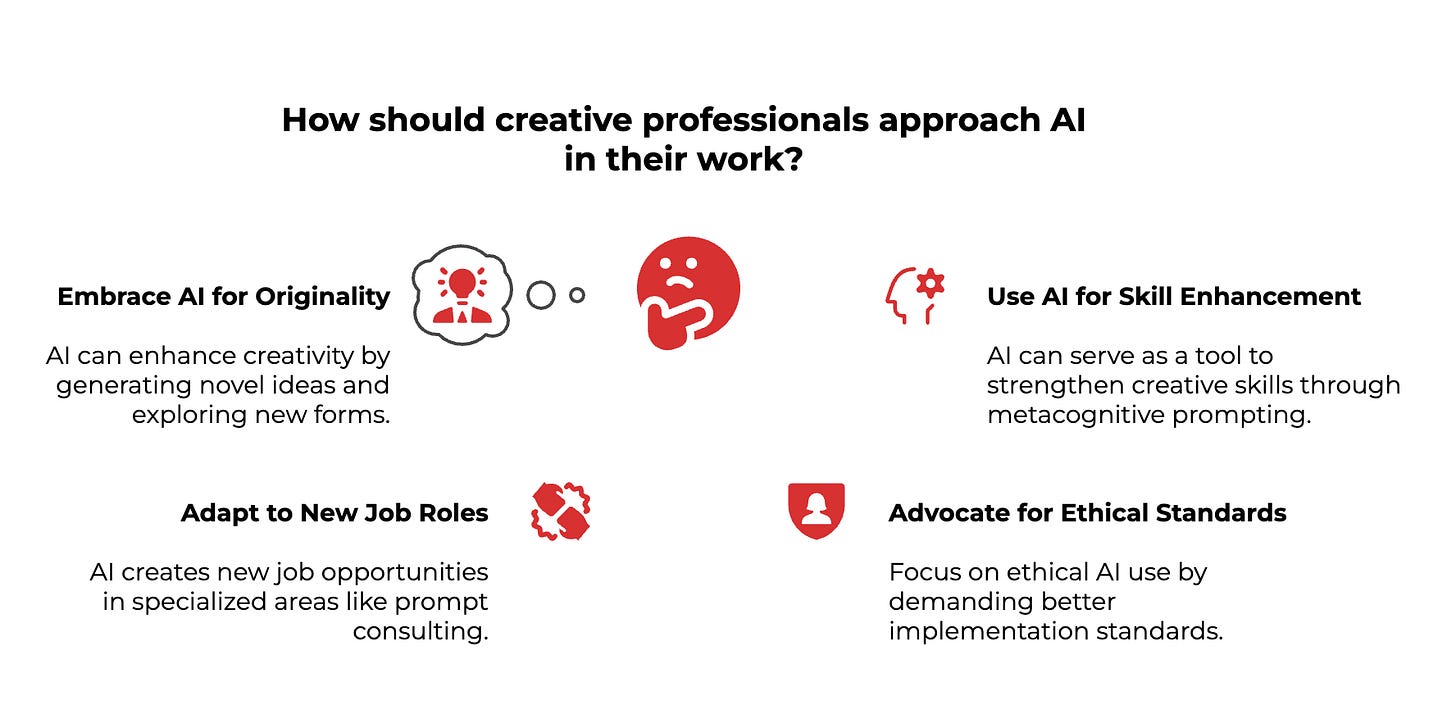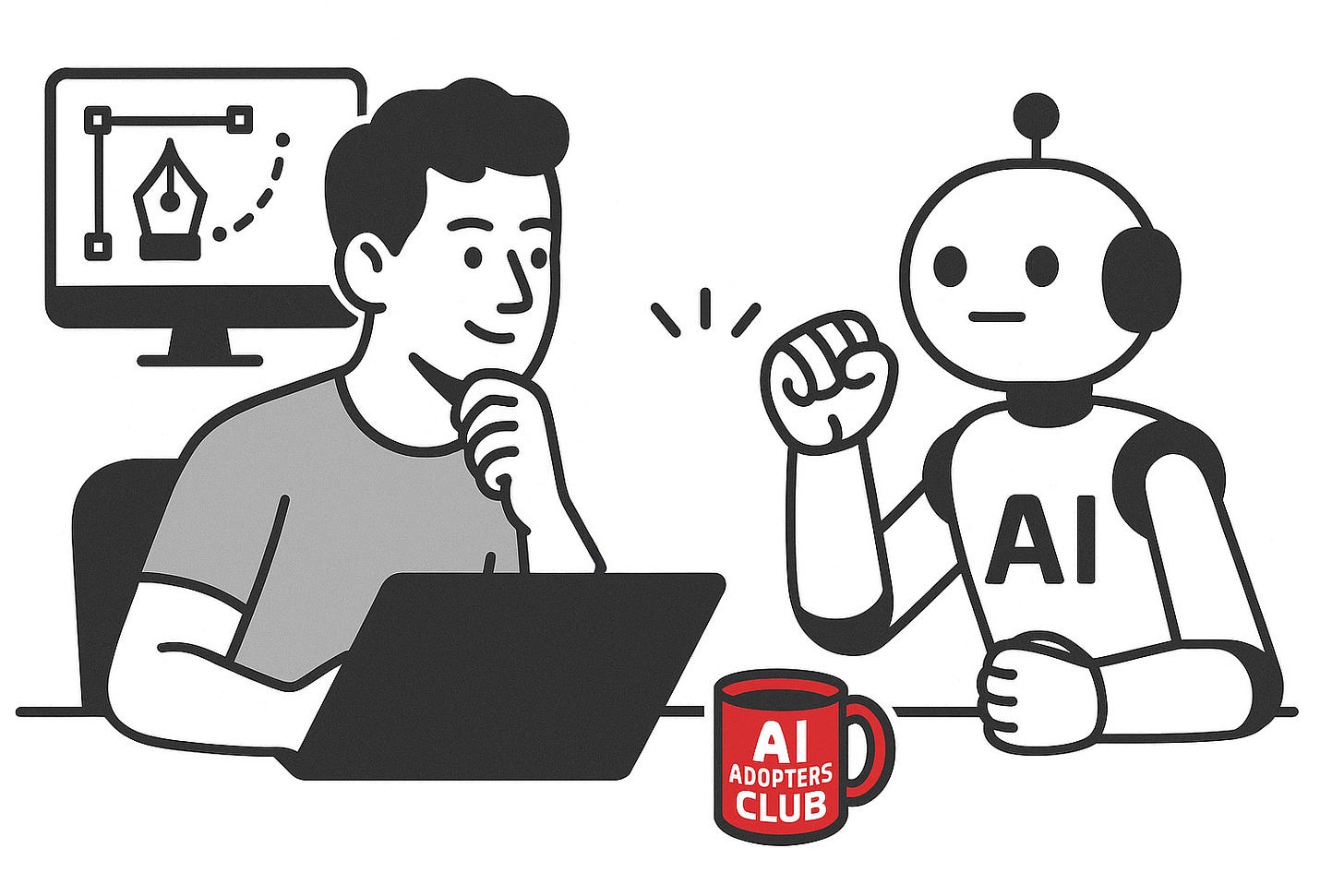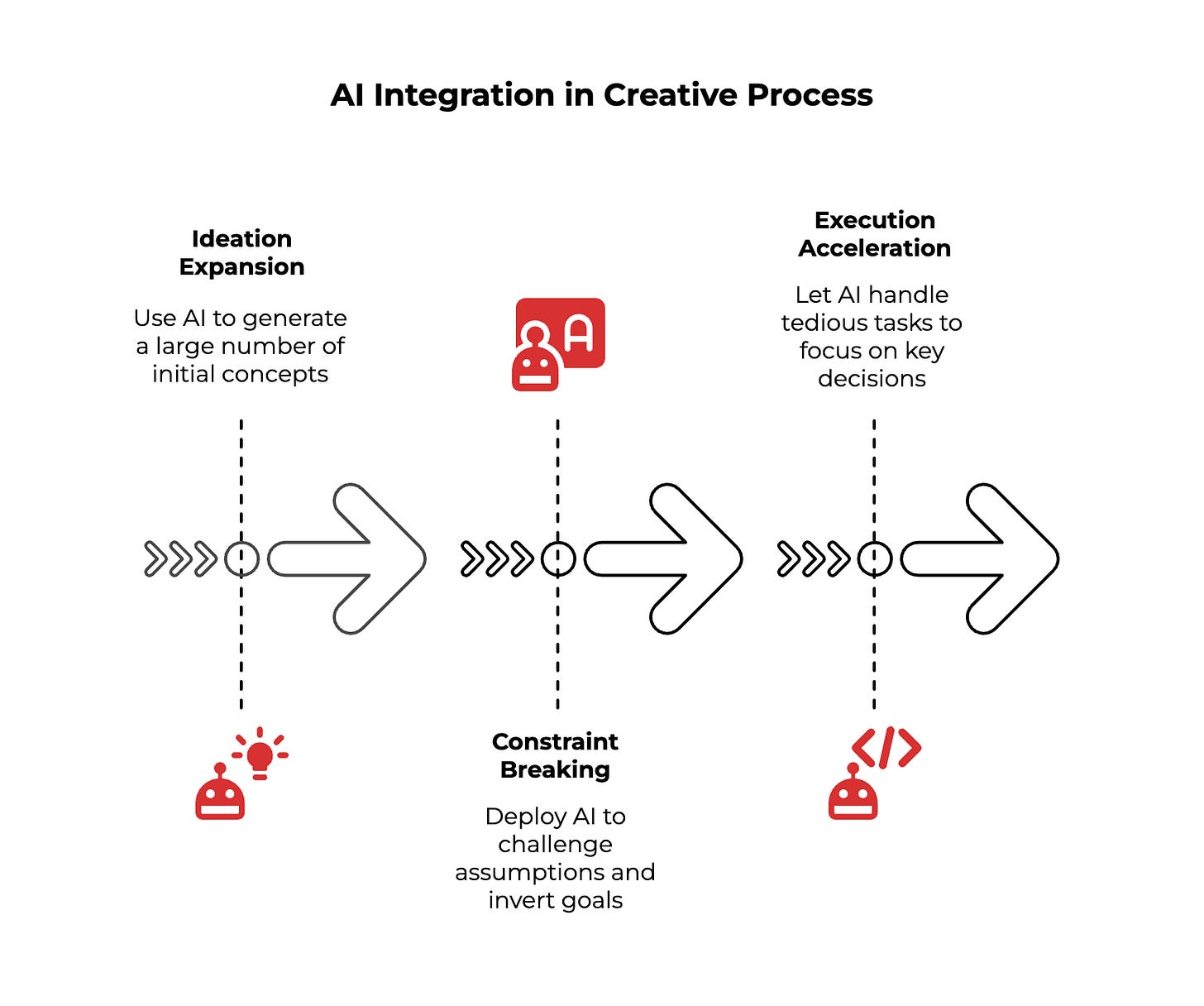Scared AI Will Kill Your Creativity?
Why Substack's Survey Missed the Real Story About Professional Growth
Hey Adopter,
Substack dropped their AI usage survey last week and the comment section exploded into a predictable creative civil war. Writers screaming about soul-crushing robots. Artists declaring war on plagiarism machines. The usual theater.
But here's what caught my attention. While everyone argued about ethics and authenticity, the survey revealed something far more interesting: the professionals quietly using AI are outpacing everyone else.
Not by replacing their creativity. By amplifying it.

Here’s my take…
This isn't another "AI good" versus "AI bad" manifesto. It's a breakdown of what the research actually shows about creative AI integration, why most objections rest on outdated assumptions, and the specific strategies that separate amateur AI dabbling from professional creative advantage.
You'll walk away with a clear framework for using AI to enhance your creative output without losing your voice, practical safeguards to avoid the pitfalls everyone fears, and actionable techniques that 83% of successful creatives already use but rarely discuss publicly.
The stakes matter. While others debate philosophy, the market is moving. The question isn't whether AI belongs in creative work. It's whether you'll use it strategically or watch competitors pull ahead.
The myths that keep creatives stuck
Myth 1: AI kills originality
The fear: AI-generated content is formulaic garbage that homogenizes everything into boring mediocrity.
The reality: Empirical tests show that LLMs actually surpass human baselines in novelty scores when guided by imaginative prompts. The difference lies in how you use the tool.
Professional novelists are using AI to generate "anti-plots" that invert their protagonist's goals, leading to more unique conflict structures than control groups working alone. Architecture students using Midjourney explore broader form vocabularies than manual sketching ever allowed.
The creative bottleneck isn't the tool. It's the quality of your questions.
Myth 2: AI dependency atrophies creative muscles
The fear: Relying on AI will make you creatively lazy and unable to think for yourself.
The reality: MIT's research confirms this only happens when users skip reflection. The same studies show that metacognitive prompting—explaining why AI suggestions work—actually reverses the effect.
It's like bilingual advantage research. Intermittent "code-switching" between AI assistance and manual work enhances neural flexibility rather than weakening it.
The professionals getting stronger use AI as a sparring partner, not a crutch.
Myth 3: AI equals job replacement
The fear: AI will eliminate creative jobs entirely.
The reality: U.S. Bureau of Labor Statistics data shows a 6% increase in freelance illustration contracts and 4% rise in self-published titles in 2024—the first full year of mass AI adoption.
Rather than job loss, the market is fragmenting into new micro-niches: prompt consultants, AI brush pack designers, synthetic character riggers. Adobe's global survey found 66% of professionals report AI helps them iterate faster while 58% deliver final assets sooner without working longer hours.
The shift isn't replacement. It's specialization.
Myth 4: All AI use is ethically tainted
The fear: Any AI assistance makes you complicit in stolen intellectual property.
The reality: Federal courts are more nuanced than creative Twitter would suggest. Recent rulings target scraping methods, not users of the tools. Infringement requires "substantial similarity" and traceability, not mere AI assistance.
Professional frameworks are emerging. Licensing deals through Shutterstock and Adobe Stock. Enterprise models with indemnification. RAG systems trained only on licensed corpora.
The solution isn't boycotting the technology. It's demanding better implementation standards.
The professional approach to creative AI
Smart creatives aren't using AI to replace their thinking. They're using it to think better.
The 3-Layer Integration Model
Layer 1: Ideation Expansion Use AI to generate 3x more initial concepts than you'd create manually. Not because AI ideas are better, but because more raw material leads to better final selection. Research shows that fluency (quantity of ideas) correlates strongly with originality when humans do the curating.
Layer 2: Constraint Breaking Deploy AI to challenge your assumptions. Ask it to argue against your creative decisions. Generate "anti-briefs" that invert your project goals. Newsroom experiments using AI as editorial devil's advocate led to 18% higher logical coherence ratings from fact-checkers.
Layer 3: Execution Acceleration Let AI handle the tedious parts so you can focus on the decisions that matter. Background research, initial drafts, layout variations, color palette exploration. Then apply your judgment, taste, and revision skills where they create the most value.
The Reflection Protocol
End every AI session with three questions:
Why did this output work or fail?
What patterns am I noticing in the suggestions?
How would I modify this approach manually?
This simple practice prevents cognitive offloading while building your ability to direct AI more effectively over time.
The Multi-Model Strategy
Don't get locked into one AI system. Rotate between Claude, ChatGPT, and Midjourney for different project phases. Use local models like FLUX for full control over sensitive work. Academic studies show this prevents stylistic convergence while maintaining creative diversity.
Your implementation roadmap
Week 1: Audit Your Current Process Track how you spend creative time. Identify the 20% of tasks that generate 80% of your value. These stay human-only. Map the remaining 80% for potential AI acceleration.
Week 2: Establish Guardrails Set limits before you start. Maximum 40% AI-generated content in any final deliverable. Weekly AI-free sprints to keep manual skills sharp. Mandatory reflection notes for every AI session.
Week 3: Begin with Low-Stakes Projects Start AI integration on personal work or client projects with flexible deadlines. Learn the tools when the pressure is low and mistakes are acceptable.
Week 4: Measure and Adjust Compare your output quality, speed, and satisfaction before and after AI integration. Double down on what works. Abandon what doesn't.
The professionals winning with AI aren't the ones using it most. They're the ones using it most thoughtfully.
What the survey actually revealed
Substack's data shows the creative divide isn't about age, income, or technical skill. It's about mindset.
The 45% using AI are experimenting, learning, and adapting. The 52% avoiding it are protecting an increasingly narrow definition of "authentic" work while their competitors expand their capabilities.
Studies of DeviantArt users found a 50% jump in monthly output immediately after adopting text-to-image tools, with sustained gains six months later. Not because AI replaced their creativity, but because it removed technical barriers that were limiting their expression.
The question isn't whether AI belongs in creative work. The market already answered. The question is whether you'll use it strategically or let others capture the advantage.
Your creative muscles don't weaken from having better tools. They atrophy from refusing to adapt.
Adapt & Create,
Kamil







I'm a techie (former developer from way back, with experience in Cobol, SAP, and project management), so I'm always intrigued by new technology. I understand the fears, too. I've now adopted AI as a productivity tool and creativity challenger. I use ChatGPT, Claude, and perplexity. I appreciate how your article addresses the concerns and the opportunities. I learned about new tools and job opportunities (I'm developing an AI Career Prompt Guide as a toolkit for my book - Prompt Consulting validated my approach, thank you!). Just imagine if we didn't learn, use, and work to improve new technology? Then how would innovation be developed and defined? I used a lot of words to say that I really appreciate your newsletter (even when some of the content is more technical than I can understand, lol).